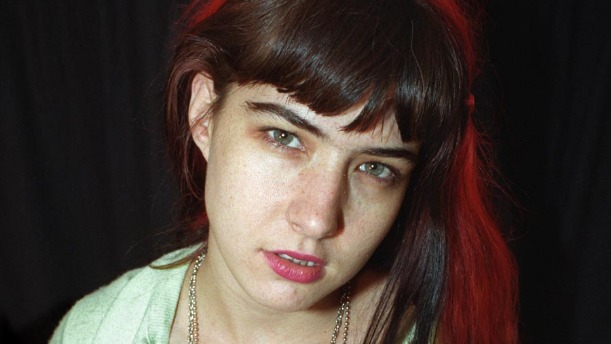those certain females: kathleen hanna
 The year is 1991: combat boots stomp along the sidewalk, the smell of freshly-Xeroxed punk zines permeates the air, and Kathleen Hanna rules supreme.
The year is 1991: combat boots stomp along the sidewalk, the smell of freshly-Xeroxed punk zines permeates the air, and Kathleen Hanna rules supreme.
You may be Le Tigre’s biggest fan; you may have Hanna’s face plastered all over your wall and may be able to recite the words to ‘Suck My Left One’ backwards. But, let’s face it; this isn’t the early 90s anymore, so what’s more likely is that you have only faint knowledge of the riot grrrl movement and its rambunctious leader. You feel as a dutiful feminist it is one of those things you really should be fluent in, but are too afraid to lean over to the person next to you and whisper, ‘So what is a Kathleen Hanna exactly?’
Well, dear friend, lace up your Doc Martens and slash your baggy jeans, as we venture onwards to find out more about everyone’s favourite riot grrrl.
The riot grrrl movement itself describes the period roughly spanning from 1991to the mid-1990s, in which innumerable female punk bands sprang up on the West Coast of America and began leaping around stages and screeching about the things that made them angry. It was a reaction to the insular male-dominated punk scene of the late 80s, which saw most girls relegated to roles as ‘coat hangers’, standing on the edge of the band room holding the jackets of their boyfriends who jumped around at the front.
Kathleen Hanna may not have singlehandedly birthed the riot grrrl movement – to claim that would be to discredit other important figure – but her name is intimately entwined with the scene. As front-woman of some of the movement’s most seminal and influential groups, most notably Bikini Kill, her name and distinctive vocal howl is almost synonymous with riot grrrl.
A self-proclaimed feminist since the age of nine, her mum—who before divorcing Hanna’s father had been a regular stay-at-home housewife—began reading Betty Friedan and becoming interested in feminist ideas.She took young Kathleen to a rally at which Gloria Steinem spoke. Speaking to Bust, Hanna said of the event, ‘It was the first time I had ever been in a big crowd of women yelling, and it really made me want to do it forever.’
Throughout college, Hanna studied photography, often exploring themes of sexism throughout her work. She set up a gallery that doubled as a platform for local bands. Eventually, after forming a string of excellently-named punk bands —Amy Carter, Viva Knievel, etc — out of this sweaty, punky rubble emerged Bikini Kill.
In the documentary ‘Don’t Need You: The Herstory of Riot Grrrl’, Bikini Kill’s first show is described as ‘one of those landmark shows where the impact reverberates the whole scene’ by DC Punk historian, Mark Anderson.
They released album titles like Pussy Whipped, and lyrics of the sordid variety: This is a song about 16-year-old girls giving carnies head/for free rides and hits of pot. Coupled with Hanna’s penchant to convulse around on stage and simply drone ‘Feminist…dyke…whore’, or make vomit noises into the microphone, this was punk music in all its gloriously offensive finery. Yet it came from a feminine perspective, which was something that had not really been expressed before.
More and more girls began going to shows, where they had been previously deterred by the high concentration of sweaty, unfriendly man-punks. Along with the fertile zine culture that buzzed along beside it, the riot grrrl period initiated a forum of ideas specific to young women.
But, like any good punk song, the movement burnt bright and fast. Due to various factors including the interference of mass media, riot grrrl had largely dissipated only a few years after it began.
But Kathleen Hanna was not ready to go quietly. In the latter half of the 1990s the more experimental, electro outfit Le Tigre was formed. Hanna may have matured slightly from the adolescent fury of Bikini Kill, but the band’s lyrics continued to explore feministic themes.
Since Le Tigre’s hiatus in 2007, Hanna has kept herself suitably occupied. She has developed a solo project, worked at a music camp for teenage girls, married a Beastie Boy, and contributed frankly to the debate surrounding abortion rights (Hanna herself experienced an abortion at the age of 15).
Even though the riot grrrl movement has admittedly faded into obscurity like a pair of thrift store denim overalls (minus the exploits of a few badass Russians), Hanna’s importance to punk music will not easily be forgotten and her name will always echo throughout the avenues of feminist lore.
Punk can still feel like a male-dominated world today; maybe there has even been a retrograde since the 90s. Yet Kathleen Hanna’s legacy will be inspiring girls to pick up guitars for generations to come. If ever you feel jaded by the state of the modern world, spin a copy of Pussy Whipped, close your eyes, and think back to a time where midriff-bearing t-shirts and scrunchies were common sartorial choices and femme-punks ruled the night.

